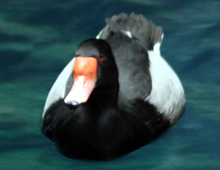Description: Male Rosy-billed pochards have a bright rosy red bill with a bulbous basal shield that increases in size and color during the mating season. The head, neck, breast and back are purplish-black and the flanks have black and white wavy lines. The legs and feet are yellow to orange. Females are almost all brown with a darker back. The breast is also barred with a darker brown. The bill is bluish-gray with a black tip. The legs can be yellow-orange to grayish. Young are similar to the females in appearance, but are darker brown on their underparts.
Size: Adults grow to about 22 inches (56 cm) in length and weigh 2.2-2.6 pounds (1-1.2 kg).
Behavior: Rosy-billed pochards are highly social and may congregate in flocks of thousands. They feed by dabbling on the surface of the water or upending in shallow water, but they rarely dive. Occasionally they graze on the land as well. Pairs are not monogamous, but will form a seasonal bond during each breeding season.
Diet: Diet consists mainly of seeds, roots, aquatic plants, grasses and sedges.
Communication: Courtship displays are performed before breeding and consist of conspicuous movements by both sexes. They do exaggerated drinking activities, mock preenings, head bobbings and neck extensions.
Reproduction: Nests are made from plant matter and lined with down. They are usually built over the
water or at the water’s edge. Breeding generally occurs in October and November and is done in single pairs or loose groups. The female lays up to ten cream to greenish eggs and she may lay her eggs in another bird’s nest. Eggs are incubated for 27-29 days. Fledging generally occurs within 50-75 days. Females raise ducklings without the males. Broods sometime merge.
Habitat/range: Rosy-billed pochards are found in shallow freshwater swamps, marshes and small lakes. They occur in central Chile and in the eastern part of South America from south Brazil and Paraguay to Rio Negro and Argentina.
Status: Listed as least concern on the IUCN Red List.



